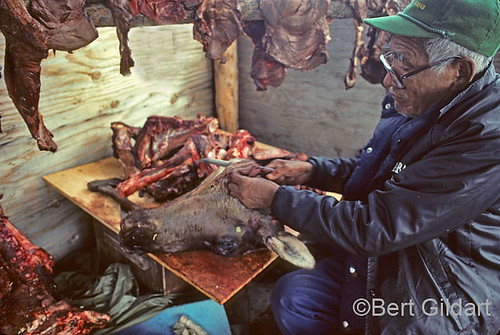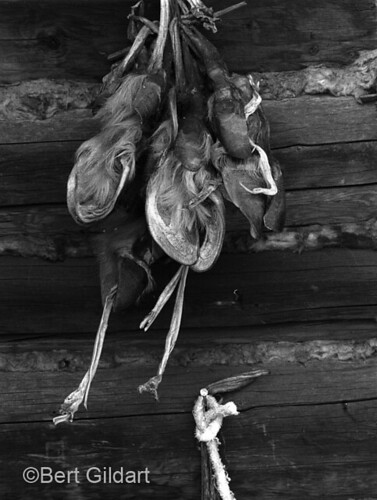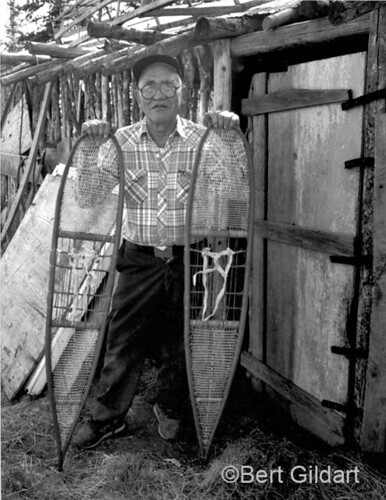Recalling Gwich’in Indian Elder Hamel Frank
©Bert Gildart: Recently I have seen images on Kenneth Frank’s Facebook page recalling his father, Hamel Frank. His images also stir strong memories for Janie and me, for our experiences in the Arctic created lasting friends, and one of them was Kenneth’s father.
Hamel was a great man, and we got to know him over a period of about ten years. During a portion of that time, we taught school, but then later returned as journalists, which also enabled me to gather information about one of North America’s most remarkable group of people. As well, we hiked the Arctic Refuge and then another summer, spent four months living out of a wall tent as we journeyed along the Yukon and Porcupine Rivers in our johnboat. (I think this epitomizes the ultimate form of freedom.)
The group of people I’m referring to are known as the Gwich’in, and they live further north than any other group of Indians, specifically, they live just south of the Brooks Ranger in Alaska. Hamel Frank was one from that group, and we got to know him through our friends Kenneth and Caroline Frank. (Kenneth, incidentally, says he was graduated from the college at Gold Camp, which really means he is a student of his environment and has the knowledge to help preserve the ways of his ancestors.)
While I taught school Janie would visit elders such as Hamel and jot down the stories these people related. One of those stories tells of a hunting experience, but more importantly, it recalls the importance of caribou to this group, many of whom still work as subsistence hunters. From Hamel’s recollections, I provide the following, a recollection which tells of a time of near starvation:
Several days later Hamel recalled that his older brothers, Nathaniel and Elaa, lashed on their snowshoes and sought help at Christian Village, some 30 miles away. They took with them one blanket and the hind leg of a porcupine. Their timing was just right, and that, according to Hamel, was luck, because in those days people were scattered and could have been out hunting or trapping. But Jim Christian, Ambrose William and Moses Sam were there, and for Nathaniel and Elaa that was even more good luck.
During the winter, the three young men had been camping over by Tt’oo tthoo van (Brown Grass Lake), and next day, they returned for some of the food they had cached. They stayed the night and in the morning, they hitched up their dogs, put a little food in their toboggan and returned to Christian Village. Nathaniel and Elaa then snowshoed back to Ch’at’oonjik (Crow Nest River), taking with them what little food could be spared…
“Now we are better,” said Hamel with a nod. “And now, it’s going on to spring. But the only place there was caribou was over on the Sheenjik. So now everyone was going over to the Sheenjik and started killing caribou. People from Arctic Village go to the Sheenjik. But not us,” said Hamel.
L TO R: The Gwich’in use everything from the caribou, even the hooves, which they boil to create
a broth, eaten when times were hard; Hamel Frank with pair of snowshoes which he made.
Hamel explained that that summer they stayed in Arctic Village. But later that fall they went to Big Rock Mountain [just north of Gold Camp] and with the help of Arctic Village residents, they built a cabin. Here, they waited for the caribou, which soon began their return from the north.
“Then the caribou were going back south there were so many,” exclaimed Hamel. “At first, we just watched the caribou migrating.
“That was a better year! That year,” smiled Hamel, “there were lots of caribou trails…”
Janie and I both believe that the opportunity to work with these people has provided us with some of our most memorable experiences, and we hope that the ways of the Gwich’in will always be respected. To learn more about this group you can check out Kenneth Frank’s Facebook page, and the website of the Gwich’in Steering Committee. You can also see more of my experiences with Kenneth by following this link which tells of an incredible ice fishing trip.
————————–
THIS TIME TWO YEARS AGO:
*In A Field Where Camas Grows (This story tell about Chief Joseph, the famous Nez Perce Indian)
BOOKS YOU NEED TO EXPLORE MONTANA, GLACIER AND SHENANDOAH:
4th ed. Autographed by the Authors
Hiking Shenandoah National Park
 Hiking Shenandoah National Park is the 4th edition of a favorite guide book, created by Bert & Janie, a professional husband-wife journalism team. Lots of updates including more waterfall trails, updated descriptions of confusing trail junctions, and new color photographs. New text describes more of the park’s compelling natural history. Often the descriptions are personal as the Gildarts have hiked virtually every single park trail, sometimes repeatedly.
Hiking Shenandoah National Park is the 4th edition of a favorite guide book, created by Bert & Janie, a professional husband-wife journalism team. Lots of updates including more waterfall trails, updated descriptions of confusing trail junctions, and new color photographs. New text describes more of the park’s compelling natural history. Often the descriptions are personal as the Gildarts have hiked virtually every single park trail, sometimes repeatedly.
Big Sky Country is beautiful
Montana Icons: 50 Classic Symbols of the Treasure State
![]() Montana Icons is a book for lovers of the western vista. Features photographs of fifty famous landmarks from what many call the “Last Best Place.” The book will make you feel homesick for Montana even if you already live here. Bert Gildart’s varied careers in Montana (Bus driver on an Indian reservation, a teacher, backcountry ranger, as well as a newspaper reporter, and photographer) have given him a special view of Montana, which he shares in this book. Share the view; click here.
Montana Icons is a book for lovers of the western vista. Features photographs of fifty famous landmarks from what many call the “Last Best Place.” The book will make you feel homesick for Montana even if you already live here. Bert Gildart’s varied careers in Montana (Bus driver on an Indian reservation, a teacher, backcountry ranger, as well as a newspaper reporter, and photographer) have given him a special view of Montana, which he shares in this book. Share the view; click here.
$16.95 + Autographed Copy
What makes Glacier, Glacier?
Glacier Icons: 50 Classic Views of the Crown of the Continent
![]() Glacier Icons: What makes Glacier Park so special? In this book you can discover the story behind fifty of this park’s most amazing features. With this entertaining collection of photos, anecdotes and little known facts, Bert Gildart will be your backcountry guide. A former Glacier backcountry ranger turned writer/photographer, his hundreds of stories and images have appeared in literally dozens of periodicals including Time/Life, Smithsonian, and Field & Stream. Take a look at Glacier Icons
Glacier Icons: What makes Glacier Park so special? In this book you can discover the story behind fifty of this park’s most amazing features. With this entertaining collection of photos, anecdotes and little known facts, Bert Gildart will be your backcountry guide. A former Glacier backcountry ranger turned writer/photographer, his hundreds of stories and images have appeared in literally dozens of periodicals including Time/Life, Smithsonian, and Field & Stream. Take a look at Glacier Icons
$16.95 + Autographed Copy




